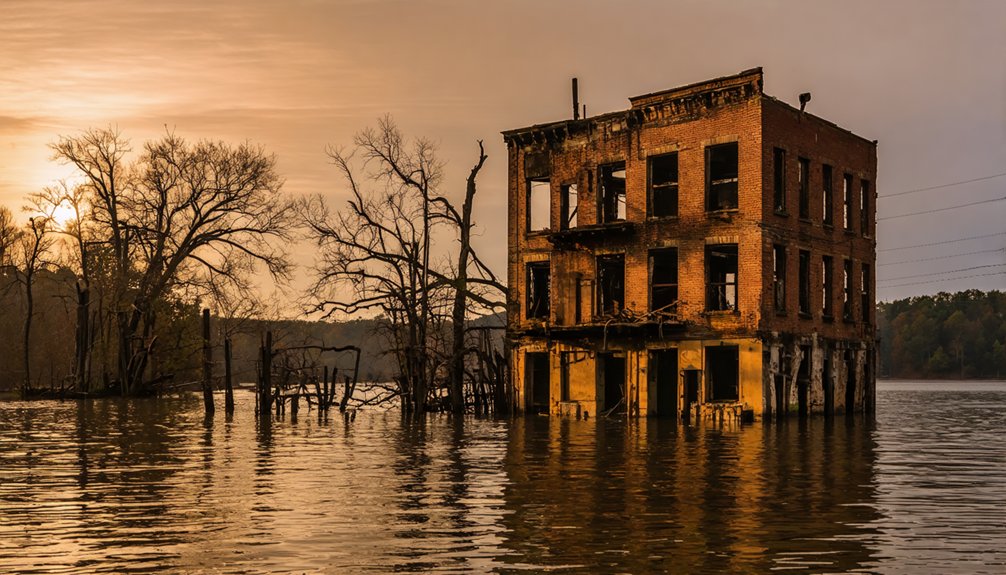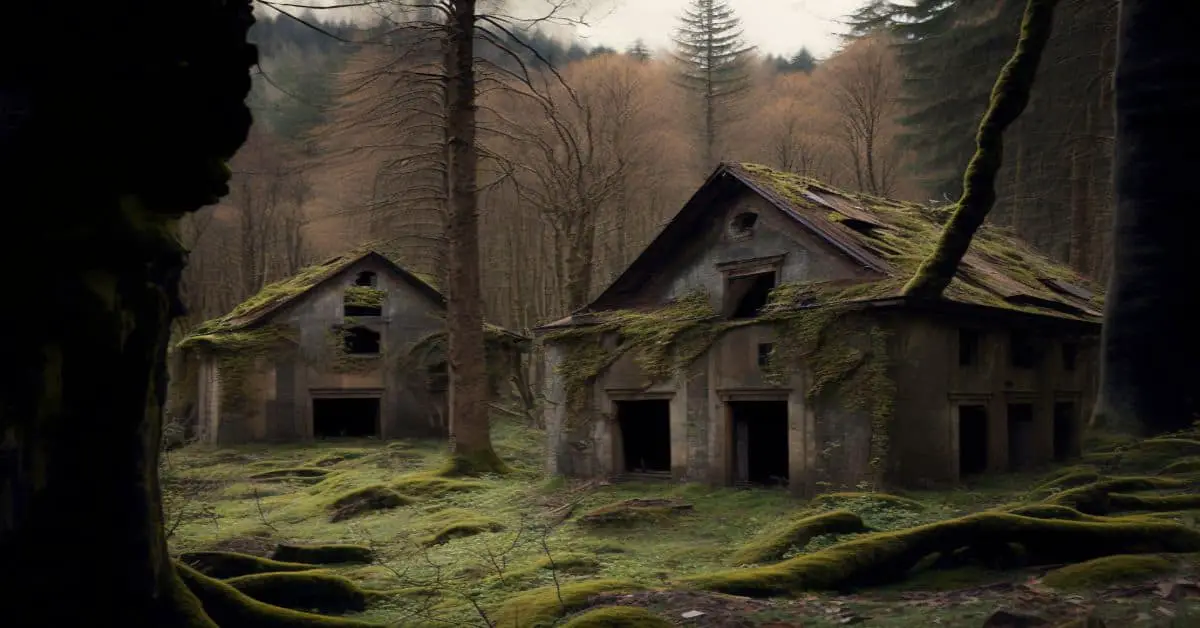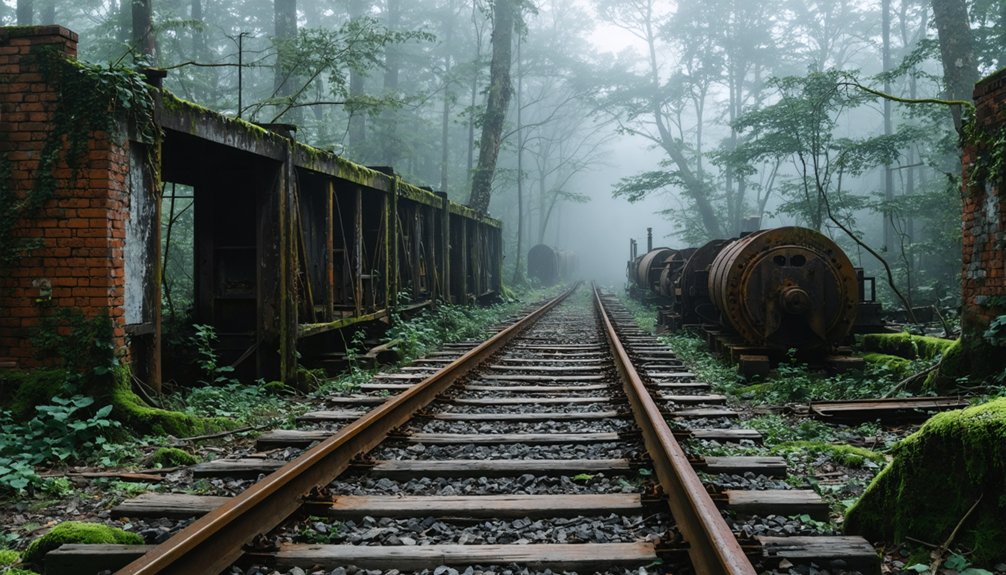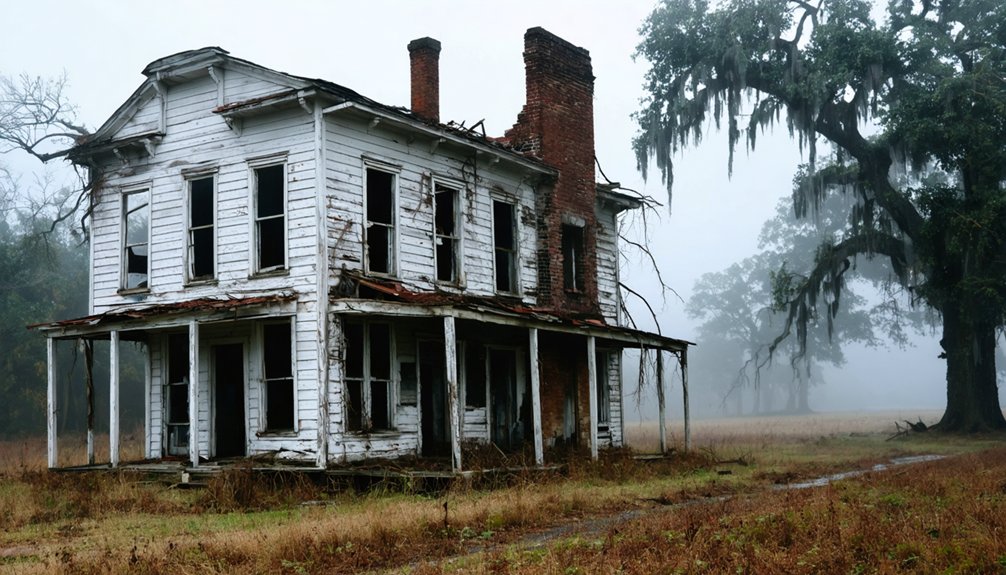You’ll find Lake Lanier’s dark past traces back to 1912, when racial violence drove over 1,000 Black residents from the prosperous town of Oscarville. By 1950, the U.S. Army Corps flooded 50,000 acres to create Georgia’s largest reservoir, submerging the remains of this ghost town along with churches, businesses, and some unmarked graves. Today, beneath the lake’s murky waters, concrete foundations and old roads tell silent stories of displaced communities and unexplained phenomena.
Key Takeaways
- Lake Lanier submerged the town of Oscarville in the 1950s, along with six churches and 15 businesses during dam construction.
- Racial violence in 1912 transformed Oscarville from a thriving Black community into a ghost town, forcing over 1,000 residents to flee.
- The underwater landscape contains remnants of the former community, including building foundations, roads, wells, and some unmarked graves.
- At least 58 Black land-owning families lost their prosperous businesses and properties due to violent displacement before the lake’s creation.
- The lake’s 38,000 acres now cover multiple historical sites, with 692 miles of shoreline concealing the remains of displaced communities.
The Birth of Lake Lanier and Its Dark Origins
When the U.S. Congress authorized Buford Dam’s construction in 1946, they’d forever change north Georgia’s landscape.
You’ll find that this massive lake transformation began in 1950, driven by Atlanta’s growing water demands and flood control needs. The project submerged over 50,000 acres of land beneath its waters, forcing more than 250 families to abandon their homes and livelihoods.
The waters claimed the town of Oscarville by 1953, along with six churches and 15 businesses. The community had already experienced tragedy decades earlier when racial violence forced many residents to flee in 1912. Despite community resilience, entire neighborhoods vanished as the lake filled to 1,071 feet above sea level. The creation of Lake Lanier would prove essential for hydroelectric power generation in the region.
While officials relocated 20 cemeteries, some family burial grounds remained beneath the rising waters. By 1958, where farms and forests once stood, you’d find a 38,000-acre reservoir with 692 miles of shoreline – a complete transformation of the Chattahoochee River valley.
Beneath the Surface: A Sunken History
Today’s placid surface of Lake Lanier masks an eerie underwater landscape filled with remnants of the communities it swallowed. Below the murky depths, you’ll find a submerged history of gravestones, building foundations, and old bridges – silent witnesses to the land’s previous life.
The U.S. Army Corps flooded this land in the 1950s, forever changing the landscape and displacing entire communities.
These physical remains create a haunting underwater archaeology site, where wells and roads still trace the paths of former residents.
You can’t escape the sobering reality that some human remains still rest beneath these waters, as not all graves were successfully relocated during the flooding.
The lake’s hidden infrastructure poses real dangers, with submerged trees, sudden drop-offs, and deteriorating structures creating hazards for modern-day visitors.
Beneath Lake Lanier’s deceptive waters lurk treacherous obstacles, from ghostly tree stumps to crumbling ruins, threatening unsuspecting swimmers and boaters.
This underwater landscape serves as both historical archive and cautionary tale, preserving a moment frozen in time beneath Lake Lanier’s surface.
The area was once home to Oscarville, a prosperous African-American community that fell victim to racial violence and forced displacement in the early 1900s.
The Displaced Communities of Oscarville
You’ll find that Oscarville’s tragic transformation from a thriving Black community into a ghost town began in 1912, when white mobs used violence and terror to force over 1,000 Black residents from their homes and businesses.
Local newspapers documented how Black families had to abandon their land and possessions, fleeing with minimal belongings as their properties were burned and seized in what became known as a “racial cleansing” of Forsyth County. The community once flourished with skilled craftsmen and laborers working as carpenters, blacksmiths, and bricklayers.
The community’s physical remnants now rest beneath Lake Lanier’s waters, but their stories endure through oral histories and historical records that reveal the devastating impact of racial violence on generations of displaced families. At least 58 black land-owning families had established successful farms, trades, and businesses in Oscarville before the massacre.
Racial Violence Drives Exodus
In 1912, a wave of racial violence devastated Forsyth County’s Black communities, centering on the town of Oscarville and stemming from unsubstantiated accusations against three Black men. The racial cleansing campaign that followed forced over 1,000 Black residents to flee their homes and abandon their properties under threat of violence from white vigilantes known as Night Riders.
Mae Crow died on September 23, 1912 without ever regaining consciousness or identifying her attackers.
- Rob Edwards was lynched by a mob, while Ernest Knox and Oscar Daniel were executed after a trial by an all-white jury.
- You’ll find records of thriving Black-owned businesses and farms that were destroyed or seized without legal transfer.
Despite community resilience, the systematic violence and intimidation resulted in the complete erasure of Oscarville’s Black population by year’s end. The Atlanta History Center now collects stories from descendants of the expelled Black residents to preserve their historical legacy.
The Georgia National Guard‘s presence did little to protect Black families, who lost generations of wealth and heritage in the exodus.
Lost Community’s Hidden Stories
Beneath Lake Lanier’s waters lies the forgotten story of Oscarville, a once-thriving Black community established during Reconstruction in the late 1800s. Through Oscarville memories passed down by descendants, you’ll discover a self-sustaining town where Black farmers, carpenters, blacksmiths, and bricklayers built prosperous lives despite systemic oppression.
The community’s resilience shone through its network of churches, businesses, and extended families like the Daniels. Night riders and mobs terrorized the residents until they fled, leaving their homes and land behind.
Yet by 1912, over 1,000 Black residents were forced to abandon their homes and livelihoods, selling their property under duress or losing it entirely.
Today, descendants work to reclaim these buried narratives through oral histories, music, and academic research, fighting against the erasure of their ancestors’ achievements and the ongoing legacy of displacement that haunts the region.
Underwater Legacy Lives On
While Lake Lanier‘s waters now cover the remnants of Oscarville, the traumatic legacy of the 1912 racial expulsion continues to ripple through generations.
The cultural memory lives on through descendants who’ve preserved their family histories despite systematic attempts to erase their community’s existence. You’ll find no markers at Lake Lanier acknowledging the thriving Black settlement that once stood there, yet community resilience endures through recently documented oral histories and genealogical research.
- The lake’s creation in the 1950s submerged not just buildings, but evidence of Black land ownership and prosperity.
- Descendants are now reconnecting through history initiatives and sharing their ancestors’ stories of displacement.
- Recent academic research and artistic works keep Oscarville’s memory alive, challenging the long-enforced silence.
Tales of the Lady of the Lake
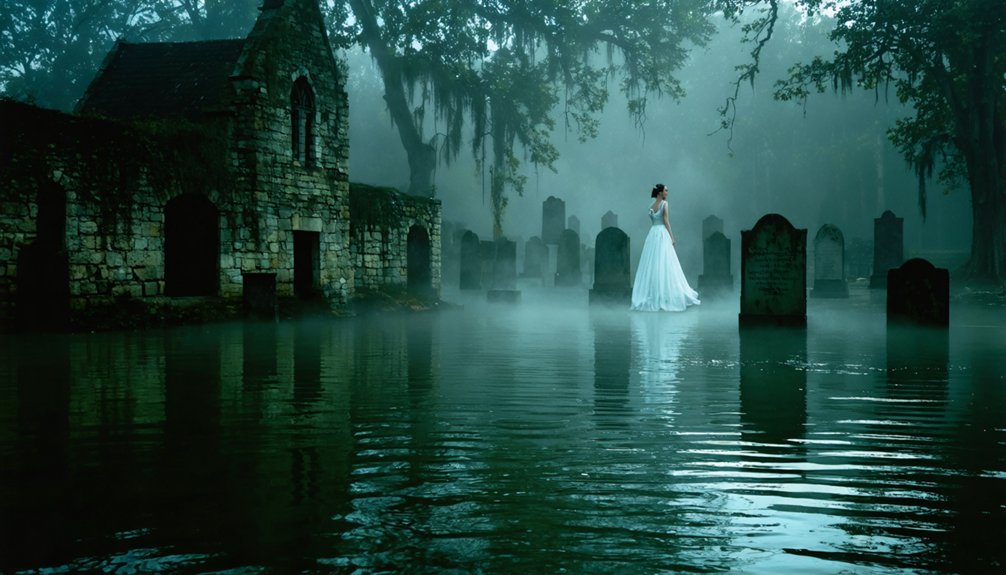
Among Lake Lanier’s most enduring supernatural tales stands the haunting legend of the Lady of the Lake, born from a tragic 1958 car accident that claimed the lives of Susie Roberts and Delia Parker Young.
After their car plunged off Browns Bridge, only Young’s body was recovered, missing hands and toes, while Roberts’ remains were never found.
In the murky depths beneath Browns Bridge lies an unsolved mystery: one body found mutilated, another lost forever to Lake Lanier’s waters.
You’ll hear of ghost sightings near Browns Bridge, where witnesses report a spectral figure in white or blue, matching Roberts’ final attire.
These spectral encounters often occur at night, with the apparition illuminated by moonlight before vanishing into thin air. The spirit is known to extend her arms, gesturing for help from passersby.
While no concrete evidence exists, the legend draws paranormal enthusiasts and fuels local ghost tours.
The tale intertwines with the lake’s darker history of displaced communities and submerged towns, embodying the water’s mysterious depths.
Mysterious Disappearances and Unexplained Events
You’ll find records of inexplicable vanishings at Lake Lanier, where numerous visitors have disappeared without explanation amidst the submerged town‘s treacherous landscape of hidden structures and unmarked graves.
Some documented cases describe swimmers who’ve descended into the murky depths and were never seen again, while others detail mysterious boating accidents where victims’ remains were only partially recovered.
Your research into these incidents reveals a disturbing pattern: the lake’s underwater obstacles, including 60-foot trees and remnants of old homes, have complicated many recovery efforts and left countless cases unsolved.
Vanishing Without A Trace
Since Lake Lanier’s creation in the 1950s, the mysterious waters have claimed over 600 lives and sparked numerous unexplained disappearances.
You’ll find that many vanishing mysteries remain unsolved, including the haunting case of Delia Parker Young, whose body was discovered missing hands and toes.
The murky depths and submerged structures create perfect conditions for ghostly sightings and unexplained phenomena.
- The infamous Lady of the Lake incident from 1958 left investigators baffled when only one body was recovered from a fatal car accident.
- Recovery teams struggle with visibility and dangerous underwater obstacles, including 60-foot trees and remnants of old buildings.
- Local folklore suggests that the displaced communities and disturbed gravesites contribute to the lake’s reputation for supernatural occurrences.
Unexplained Underwater Encounters
The murky depths of Lake Lanier harbor more than just submerged buildings and forgotten roads – they hold countless tales of inexplicable encounters that defy logical explanation.
You’ll find a complex underwater maze of hazards, where tall trees and hidden structures create dangerous traps for unsuspecting swimmers and boaters.
While officials haven’t confirmed any paranormal activity, the lake’s history of unexplained phenomena has captured widespread attention through media coverage and documentaries.
You’re exploring waters where submerged dangers lurk beneath the surface – remnants of Oscarville’s buildings, unmarked graves, and debris that contribute to numerous accidents and drownings.
Local beliefs in supernatural occurrences persist, though they lack scientific backing. The lake’s poor visibility and fluctuating water levels only amplify the mystery, revealing glimpses of the ghost town below at unexpected moments.
The Underwater Forest and Hidden Structures
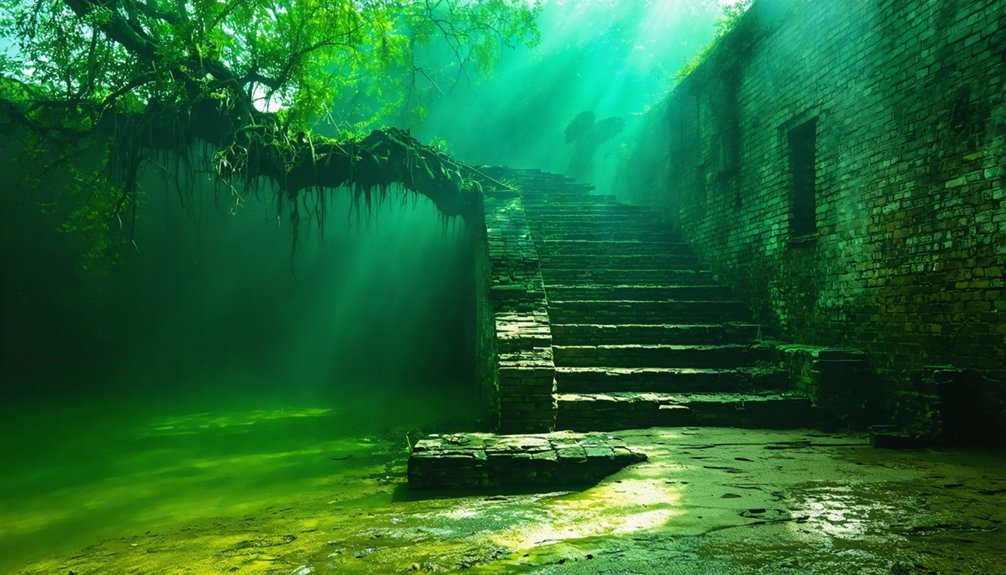
Hidden beneath Lake Lanier’s murky waters lies an eerie underwater landscape of submerged forests and abandoned structures from pre-1950s communities.
You’ll find a haunting maze of underwater hazards created during the lake’s formation between 1950-1958, when the rising waters gradually swallowed entire towns and forests. The submerged dangers include remnants of Oscarville’s buildings, roads, and bridges, alongside vast stretches of preserved trees that weren’t cleared before flooding.
- Concrete foundations, utility poles, and fences create treacherous entanglement risks for swimmers and divers
- Limited visibility of just a few feet masks sudden drop-offs and hidden obstacles
- Submerged treetops and building remains pose constant threats to boat propellers and underwater navigation
These underwater features, combined with murky conditions, make Lake Lanier a challenging environment that demands respect and caution from all who venture onto its waters.
Ghostly Encounters and Local Legends
Beneath Lake Lanier’s placid surface lies a dark legacy of supernatural encounters and haunting tales, stemming from its controversial formation in the 1950s when entire communities were submerged.
You’ll find stories of ghostly apparitions near Browns Bridge, where the infamous Lady of the Lake haunts the waters after a tragic 1958 car accident left her body partially recovered.
The lake’s haunted legends intensified as over 600 deaths occurred in its murky depths, with some bodies never found.
Local folklore warns of restless spirits from displaced communities, including the forgotten town of Oscarville and its 1,000 Black residents who fled racial violence.
You’ll hear accounts of mysterious lights, unexplained noises, and spectral figures near submerged houses, unmarked graves, and abandoned cemeteries that rest eternally in Lake Lanier’s depths.
Modern-Day Tragedies and Continuing Legacy
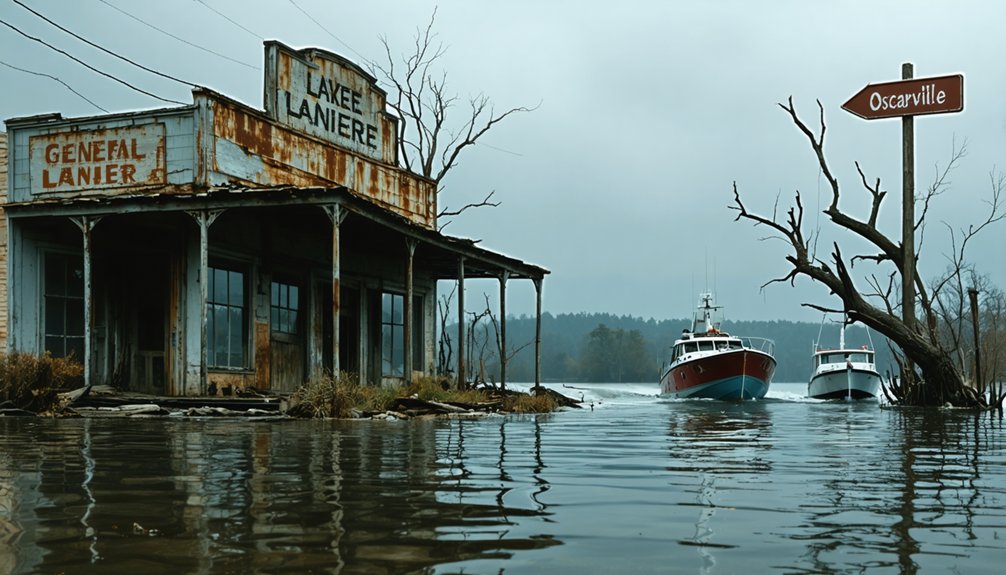
While Lake Lanier’s haunted history draws visitors, modern statistics paint an equally chilling picture of ongoing tragedies. Over 600 lives have been lost since the lake’s creation, with seven drownings in 2021 alone. The underwater landscape, filled with submerged structures and an ancient forest, creates treacherous conditions for swimmers and boaters alike.
- Local communities have strengthened safety measures, implementing stricter boating regulations and increased law enforcement patrols.
- Search and rescue operations face extreme challenges due to murky waters reaching depths of 152 feet.
- The community impact continues through regular memorials, vigils, and cautionary tales shared by residents.
Despite public awareness campaigns and enhanced safety protocols, the lake’s hazardous conditions persist. Densely submerged structures, poor visibility, and sudden weather changes contribute to its dangerous reputation, affecting both tourism and local life.
Frequently Asked Questions
Are There Any Restricted Areas of Lake Lanier Where Swimming Is Prohibited?
Picture yourself diving into cool waters – but beware. You’ll find swimming regulations prohibit lake access at Margaritaville, most marinas, and private docks. These restricted zones protect you from underwater hazards and electrical cables.
What Safety Measures Have Been Implemented Since the High Number of Accidents?
You’ll find stricter boating laws, enhanced safety regulations, and increased patrols enforcing BUI violations. Additional measures include mandatory life jacket rules, warning signs, solar lights, and thorough accident prevention infrastructure.
How Deep Can Divers Safely Explore Lake Lanier’s Underwater Structures?
Ever wondered about diving’s edge? You can safely explore structures to 70 feet, following diving regulations. Beyond that, you’ll need technical certification and specialized equipment for underwater exploration in zero-visibility conditions.
Has the Lake’s Water Quality Been Affected by the Submerged Structures?
You’ll find limited scientific evidence linking submerged structures directly to water quality issues, though they can create habitats for aquatic life and affect local water circulation patterns beneath the surface.
Are There Designated Historical Markers Around Lake Lanier Commemorating Displaced Communities?
You’ll find limited historical markers – mainly the 2018 “Lake Lanier is Born” sign focuses on engineering, not community remembrance. While cemetery relocation markers exist, there’s no widespread commemoration of displaced towns’ historical significance.
References
- https://atlantaghosts.com/terror-at-lake-lanier-and-browns-bridge/
- https://www.youtube.com/watch?v=UtY-90kcQNs
- https://styleblueprint.com/everyday/the-most-controversial-haunted-lake-in-america-gas-lake-lanier/
- https://www.goldpeachrealty.com/blog/The-History-of-Lake-Lanier-From-Creation-to-Today
- https://lakelanier.com/history/
- https://en.wikipedia.org/wiki/Lake_Lanier
- https://atlantafi.com/an-unofficial-history-of-lake-lanier/
- https://www.southerngothicmedia.com/lake-lanier
- https://lakesidneylaniermemories.com/before-the-dam/
- https://www.youtube.com/watch?v=ZBnUk0K03BQ
